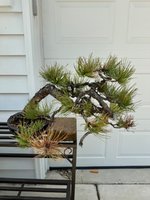nuwildcat928
Seedling
- Messages
- 19
- Reaction score
- 8
- USDA Zone
- 5b
Hi,
Bought this beautiful ponderosa pine this year. Over the summer I’ve noticed the tips on some distal branches turning brown. No clear source, perhaps trauma related. I came home one day and found the tree had fallen off its pedestal as some squirrels which have bothering my other trees apparently went after the organic fertilizer in the soil. The pot was cracked in several places, rather than repot in mid summer I was advised to duct tape the pot and repot in the spring. It is watered daily using low dose liquid fertilizer intermittently. Can anyone help?
Thanks,
Rick
Bought this beautiful ponderosa pine this year. Over the summer I’ve noticed the tips on some distal branches turning brown. No clear source, perhaps trauma related. I came home one day and found the tree had fallen off its pedestal as some squirrels which have bothering my other trees apparently went after the organic fertilizer in the soil. The pot was cracked in several places, rather than repot in mid summer I was advised to duct tape the pot and repot in the spring. It is watered daily using low dose liquid fertilizer intermittently. Can anyone help?
Thanks,
Rick


